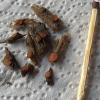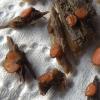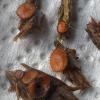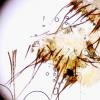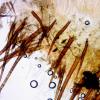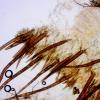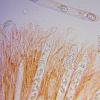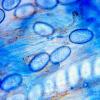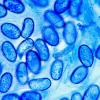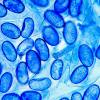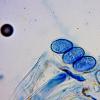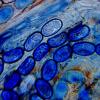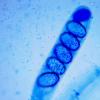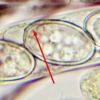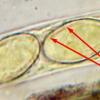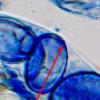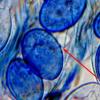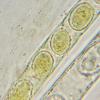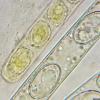
18-12-2025 21:17
Pol DebaenstThe identification took me to Byssonectria deformi

15-12-2025 07:09
 Danny Newman
Danny Newman
indet. Rutstroemiaceae sp. on unk. fallen leavesMc

19-12-2025 10:10
Patrice TANCHAUDBonjour, récolte réalisée en milieu dunaire, a

18-12-2025 17:23
 Bruno Coué
Bruno Coué
Bonjour,je serais heureux d'avoir votre avis sur c

18-12-2025 18:07
Margot en Geert VullingsThese plumes were found on rotten wood.They strong

17-12-2025 18:35
 Michel Hairaud
Michel Hairaud
Bonjour à tous/Hi to everyone I am passing along

15-12-2025 15:48
 Danny Newman
Danny Newman
Melanospora cf. lagenaria on old, rotting, fallen

15-12-2025 15:54
 Johan Boonefaes
Johan Boonefaes
Unknown anamorph found on the ground in coastal sa
Scutellinia sp. - please help with identification
Sergey Markov,
21-10-2019 21:53
I found small Scutellinia species on very wet very rotten wood of Populus tremula and Betula pendula in Russia near east of Moscow region (left from match - on Populus, right - on Betula).
Ascomata size is up to 5 mm of pale orange color. Marginal hairs up to 1.5 mm long (may be longer, I measured only seven hairs) and up to 42 um wide, non-septate, at base from non-furcate to multifurcate.
Ascospores ellipsoid or broadly ellipsoid, (17.57) 19.03 - 20.66 (21.70) × (11.84) 12.38 - 13.60 (14.19) µm; Q = (1.39) 1.47 - 1.58 (1.67); N = 49; Me = 19.78 × 13.01 µm ; Qe = 1.52. Ornamentation very small, mostly invisible in light microscope, most spores visible as smooth, but contains rare "big" warts up to 0.2...0.3um high. Ornamentation visible in lactic CB, contains ultra-small to small warts, some rare bigger warts and ridges, and some rare mesh-like structures. Paraphyses clavate, some septate, some moniliform.
I checked several versions - S.crinita (apothecia too small; spore ornamentation not suitable), S.kerguelensis (hairs too long, non septate), S.nigrohirtula (Qe too small, hairs too long, aseptate), S,setosissima (Southern specie, should not be found in my region), S.olivascens (hairs too long, Qe may be smaller than needed). I think that none of this versions are suitable.
Please help with identification.
Malcolm Greaves,
22-10-2019 08:48
Re : Scutellinia sp. - please help with identification
How about S scutellata?
Sergey Markov,
22-10-2019 11:31
Re : Scutellinia sp. - please help with identification
According to T.Schumacher (1990) S.scutellata has ascospores with warts with height of 0.5...0.9 um, clearly visible in light microscope. Spores of my Scutellinia sp. visible as almost smooth with 100x oil lens in Melzers reagent and in lactic CB. Ornamentation visible only in CB as pattern on spore surface, but not as relief on spore periphery. Warts, that are visible as relief, have maximum height of 0.2...0.3 um are very rare, hard to find, and may be also artefacts. i'm not sure that they are true warts.
If this (almost smooth mature spores with ornamentation visible as pattern, but not as relief) in conjunction with small ascomata is normal for S.scutellata, this may be acceptable version.
If this (almost smooth mature spores with ornamentation visible as pattern, but not as relief) in conjunction with small ascomata is normal for S.scutellata, this may be acceptable version.
There are two new microphotos (in Melzer's). I previously did not pay attention to this, but immature spores have a clearly visible ornamentation, warts with height up to 0.7 um, that disappears on mature spores.
Malcolm Greaves,
22-10-2019 23:21
Re : Scutellinia sp. - please help with identification
The sculpturing often changes when spores are ejected. Sometimes smaller sometimes greater so mature spores should always be used. S crinita is described as having minute sculpturing.
Sergey Markov,
27-10-2019 18:25
Re : Scutellinia sp. - please help with identification
Thank You. S crinita was my first version. I was later confused with some microphotos of S.crinita ornamentation, but these photos was mixed up. I reviewed Schumachers's description and drawings, and S. crinita seems to be almost suitable. Only with a minor incongruities - according to Schumacher S.crinita has simple septate paraphyses, and i see moniliform paraphyses in my species, and the spore ornamentation of my species looks lower than in the Schumacher's description (mainly invisible under 100x oil immersion lens as relief). Is this OK for S.crinita?
Malcolm Greaves,
27-10-2019 23:15
Re : Scutellinia sp. - please help with identification
I would accept it.

